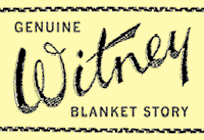What is a Witney blanket?
The obvious answer to this question is 'a blanket made in Witney' but the matter is rather more complicated than that: blankets and blanketing were made in Witney, Oxfordshire, for several hundred years and during that time very many different sizes, patterns, qualities, colours, materials and methods were used to make them. Blankets were not made by a single company or business but by lots of separate individuals and firms over the years. In turn these had a broad range of clients and customers that put them to lots of different uses. 'A Witney blanket' meant different things to different people and its meaning also changed over time.
 Label from a 'Witnedown' blanket made by Smith and Philips'.
'the raised blankets of the Witney type, in which a soft spun
yarn and long fibred weft is employed. In the finishing process
of the Witney blanket the fibres are raised to form a fleecy
pile on the surface so retaining its warmth properties' [1].
This is often what people mean when they refer to 'Witney blankets'. Many people also use the term 'Witney blanket' to refer to the point blankets that were traded through the Hudson Bay Company to North America, because they are one of the most famous Witney products.
Here is some further information that may help to explain what 'Witney blanket' has meant at different times:
- During the Middle Ages 'blanquette' or 'blanket' was more of a
general term used to describe a particular type of white woollen
broadcloth, not just a name for bed coverings or a specific
product. This definition seems to have persisted, as much later
on in 1844 one description of 'Witney blanket' is given simply
as: 'A heavy cloth produced at Witney and used for men's
overcoats'.
- Witney did not really specialize in or become famous for
blankets until the early 17th century. Before this time its main
trade was undyed broadcloth (in common with many other weaving
industries in the country at that time). This was a kind of
coarse, heavy woollen cloth made from fell wool and although it
was commonly known as 'blanketing' many other things apart from
blankets were made from it. It had warmth, weight and water
repellent qualities that made it very useful for clothing such
as coats and petticoats. In 1716 John Gay referred to this in
his poem 'Trivia':
True Witney Broad-cloth with its Shag unshorn,
Unpierc'd is in
the lashing Tempest worn
- As Witney's fame for making blankets gradually increased a
'Witney blanket' came to mean not only those made in Witney, but
also any blanket of the particular soft, fleecy, good quality
type that Witney was famous for, even if they were made in
Yorkshire! The Witney name carried with it an implication of
quality.
-
 Label from a Smith and Philips' blanket produced for a client.
-
 1960s or 1970s Witney Blanket Company Ltd label for a wool and
nylon blend blanket.
|




